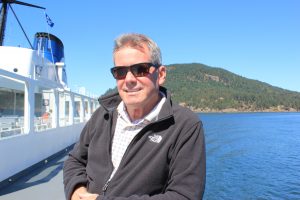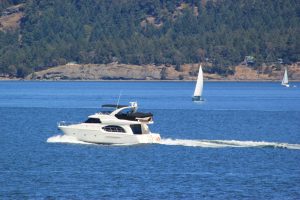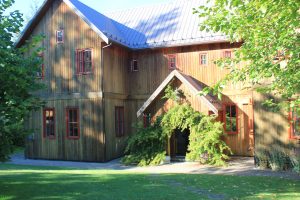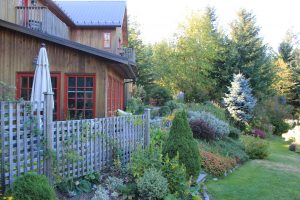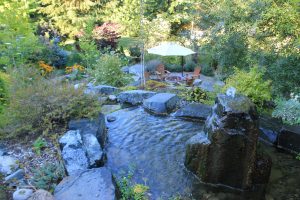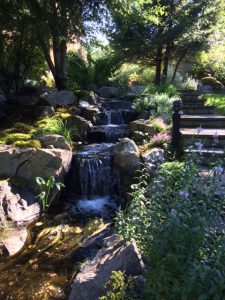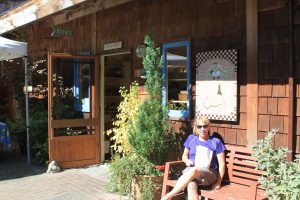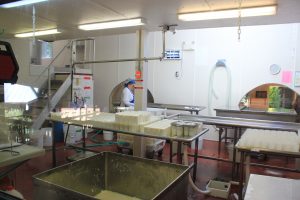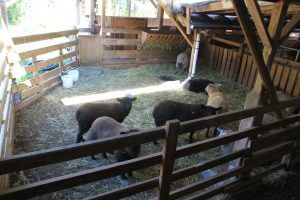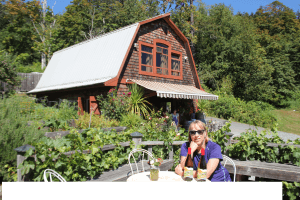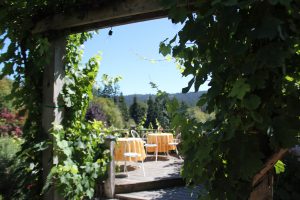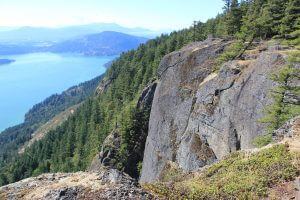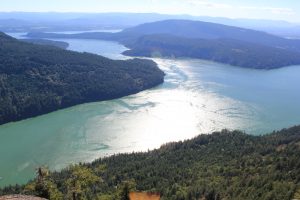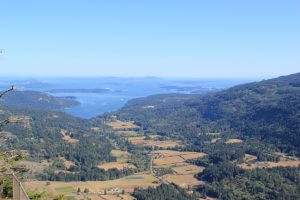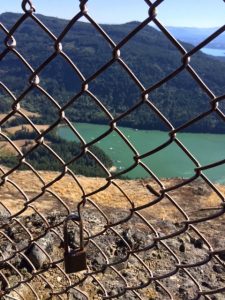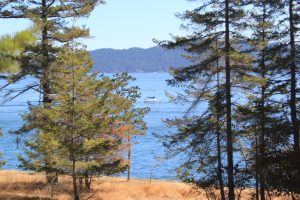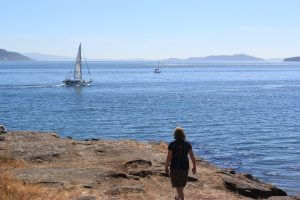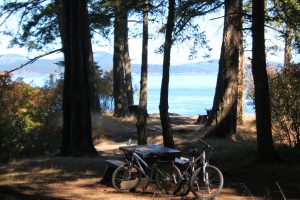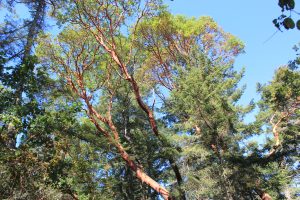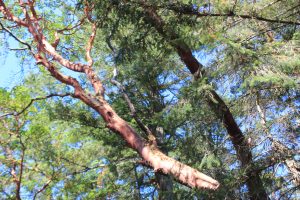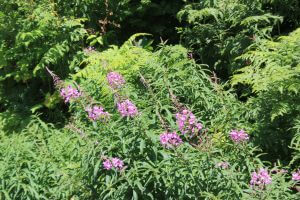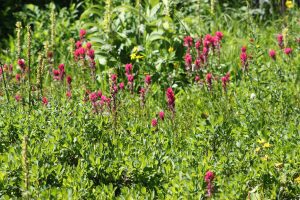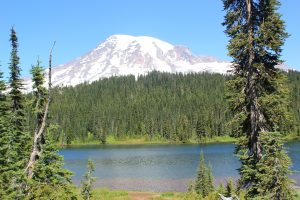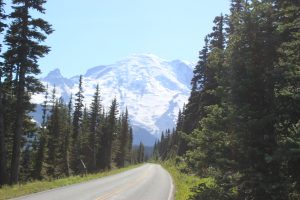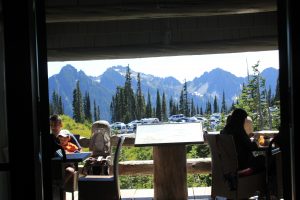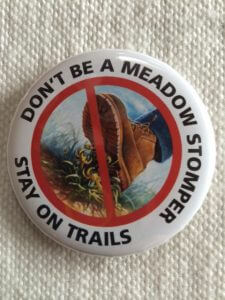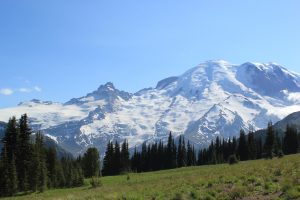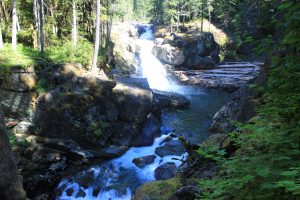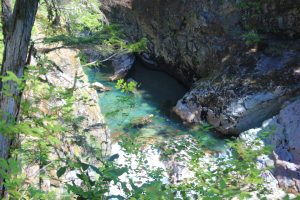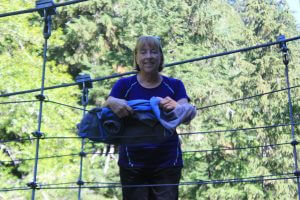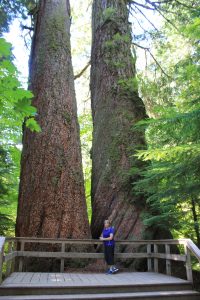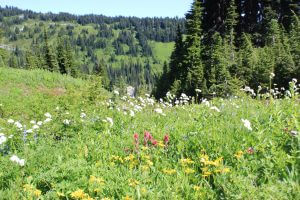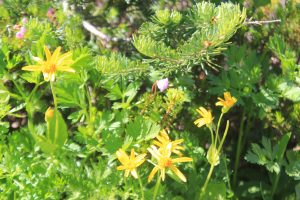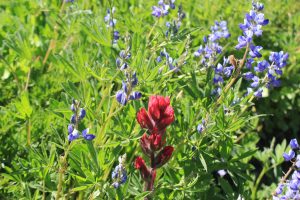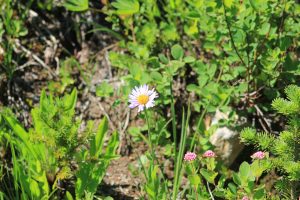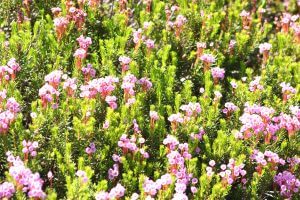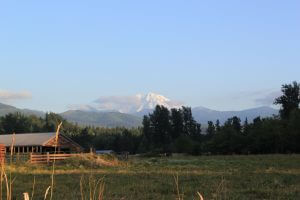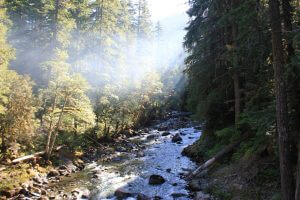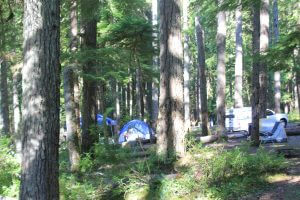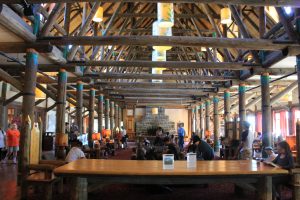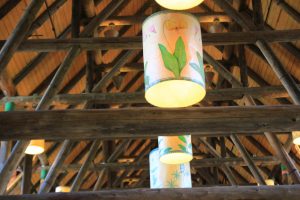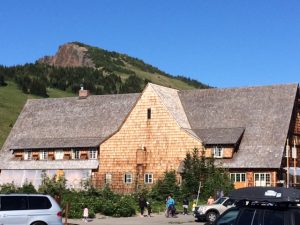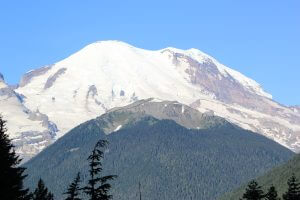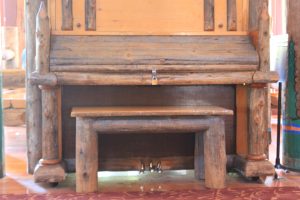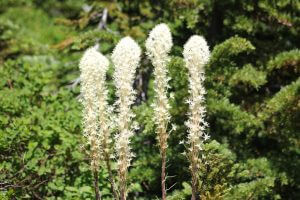
Salt Spring, the Island of Subdued Excitement
Don’t let the title fool you. Cascadia, the region including Oregon, Washington, and British Columbia, offers plenty of extreme activities, but there’s also no better place to chill and enjoy the simple pleasures of life. This week, my husband and I chose Salt Spring Island for a three-day getaway.
Under bright blue skies and near eighty-degree temperatures, we sailed to Canada’s Gulf Islands between Vancouver city and Vancouver Island. As the car ferry wove between the islands, we sat on deck, ever on the lookout for orcas. Not this time.
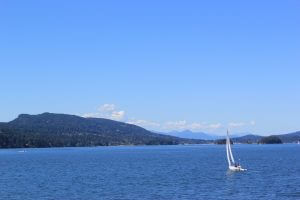
Seems like every boater was out enjoying the calm waters, and the otters were backstroking right along side them.
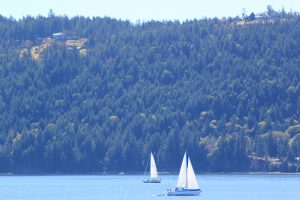 As we pulled into each port, we looked at the spectacular homes and fantasized about what it would be like to live so remotely.
As we pulled into each port, we looked at the spectacular homes and fantasized about what it would be like to live so remotely.
Salt Spring’s Subdued Accommodations
Salt Spring Island is busy in August. If travelers stay on the water, especially near the main town of Ganges, it is special and expensive—hotels could be $200 and up per night. If you were to love it there and buy a waterfront home, you’d be looking at something well over a million. A mile or so outside of Ganges, life settles down, and the interior of the island is reminiscent of San Juan Island in Snow Falling on Cedars, a quiet life in a rural setting of agriculture or forest, with school buses and pickup trucks sharing your road.
We joined our friends at the Wetherly Inn, which invites travelers to unwind in its stunning English garden.
Salt Spring Food: Farm-to-Table Fresh
One lovely discovery was how the restaurants pride themselves on fresh local food. We didn’t encounter any three-star chefs, but the quality of the food still takes you by surprise. Our first dinner of Red Snapper at the Salt Spring Inn inspired us to seek out the local food artisans.
My salad had the best goat cheese I’ve ever tasted, so the next morning we drove south to the Salt Spring Creamery.
There we found a tasting of about ten amazing goat cheeses, both soft and hard.
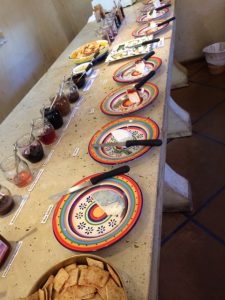 Sadly, the U.S. won’t let people import goat products, so whatever we bought had to be consumed during our trip. I could have bought one of each but settled for the lemon goat cheese and the herbal goat cheese. My husband really wanted the garlic and the one topped with tapenade, but we settled on buying the toppings separately, which can be imported.
Sadly, the U.S. won’t let people import goat products, so whatever we bought had to be consumed during our trip. I could have bought one of each but settled for the lemon goat cheese and the herbal goat cheese. My husband really wanted the garlic and the one topped with tapenade, but we settled on buying the toppings separately, which can be imported.
The Creamery is also a working farm, so we had fun looking around.
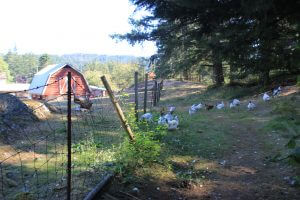
The next day we went wine tasting. The award-winning Salt Spring whites are light and dry, perfect for summer.
We bought two from Salt Spring Winery, and then went next door to Garry Oaks and bought a delicious and dry chardonnay and a red we haven’t tried yet.
On the last day, we drove into the forest to buy bread from the brick-fired bakery. The Bread Lady is only open to the public Wednesday to Friday because she sells most of her product at the Saturday morning market.
Hiking Off the Food on Salt Spring’s Prepared Trails
We did more than appreciate food during our subdued vacation. One evening we drove to the top of Mount Maxwell for sunset. Hiking along the ridge was spectacular and shows you just how close Salt Spring is to Vancouver Island.
Here is one thing that disappointed me about Mt. Maxwell. If you’ve been reading this post, you know that I loathe love locks. Tell me how this rusty lock increases the hiker’s enjoyment of the rim.
One morning we went to the tip of the Island to the Ruckles Provincial Park. Hiking along the water is always spectacular in a quiet, unspoken sort of way.
While hiking, look for the beautiful madrona tree, native to the West Coast from northern California through Cascadia. Its species name is arbutus menziesii, named after the Scotsman, Archibald Menzies, who found it.
I love to see it at its peel stage, where orange-red bark peels away to reveal a silvery greenish bark beneath.
We have been told that Salt Spring Island has lovely art galleries. We drove past a lot of glass, pottery, and painting studios on the way to food tasting and hiking. But this week we just wanted to be outside. I’m sure you can see why.
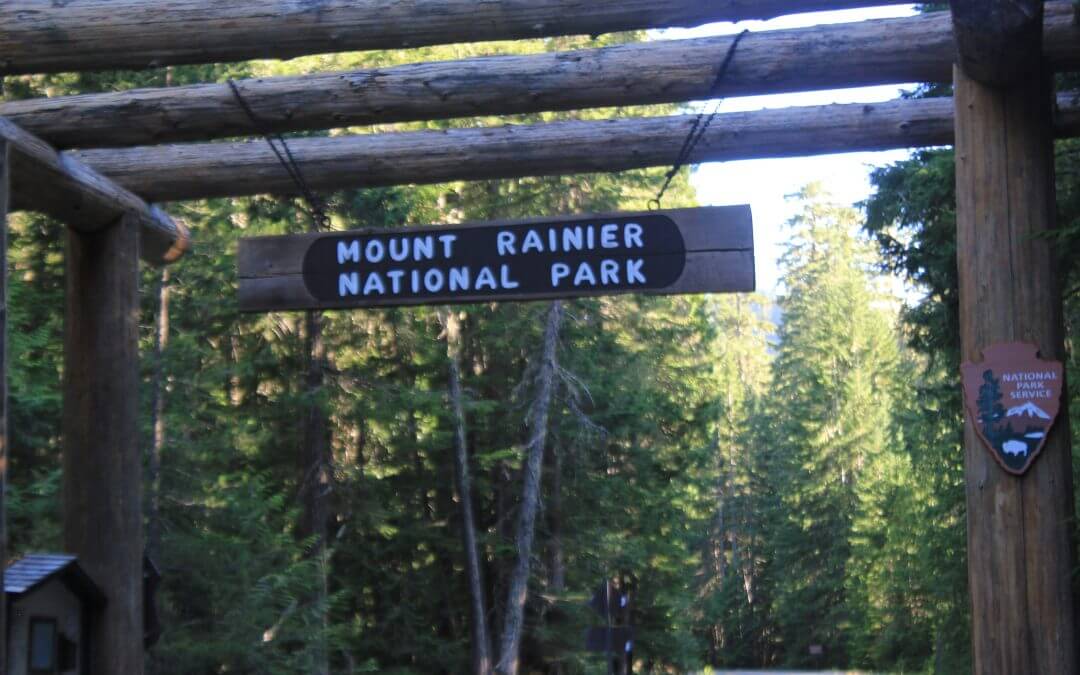
Mount Rainier: The Hills Are Alive …
Let’s keep them alive by protecting Mount Rainier National Park from being loved to death.
Mt. Rainier was America’s fifth National Park, and the first one so conserved because of its forests. In 1888 John Muir climbed to the summit of Mt. Rainier and fell in love with the place. But he was not so impressed with the mountain top as with its base and particularly the wildflowers in late summer.
“Gardens of Eden filled knee-deep with fresh, lovely flowers of every hue, the most luxuriant and the most extravagantly beautiful of all the alpine gardens I ever beheld in all my mountain-top wanderings.” Muir wanted Mount Rainier to get park status (1899) to preserve its over 900 species of plants, including over 100 species considered exotic.
“They paved Paradise to put up a parking lot.”
When World War I limited overseas travel, Stephen Mather, the first director of the National Park Service, saw an opportunity to showcase the National Parks, and the draw was luxury accommodations. Since Paradise is the most popular area of the Mount Rainier National Park, he organized the construction of the Paradise Inn. In 1931 a golf course was added as well as a ski tow rope in 1936. Other activities such as horseback riding and boating on the lakes became available. Guess he didn’t realize that Mt. Rainier was lovable for itself and didn’t need the man-made extras to attract attention.
According to Park Ranger Gwen, who led our wildflower tour last week, those activities had to be discontinued in order to protect the land and the water.
In 1907, Mt. Rainier was the first National Park to admit vehicles for a fee. This would not have been good news for Ansel Adams, who had always been anti-roads. “If I had my way about national parks, I would create one without a road in it. I would have it impenetrable forever to automobiles.”
Adams spoke out against the expansion of the Paradise Inn, explaining that its increased popularity would necessitate a larger parking lot and more roads.
He was right about one thing: parking is a nightmare at Paradise. The area expanded to three paved parking lots, which is still inadequate. After all, 1,858,763 visitors came to Mount Rainier last year. But also, think of the gas one spends in the long search for a space.
How can you help sustain Mount Rainier National Park?
Today’s efforts to preserve Mt. Rainier have gone high tech. Global warming is the new issue, and your photos of Mt. Rainier can help researchers at the University of Washington. The Meadow Watch project will use your wildflower photos from Mount Rainier to track various species year after year. They can show where certain wildflowers bloom and how they bloom after a late snowmelt or an early snowmelt. Your photos need to be date-stamped and geo-tagged by your cell phone. Then go to www.meadowatch.org for instructions on how to submit.
The Park Rangers on site work hard to preserve the wildflowers, which are so crucial to ecological sustainability. The hiking paths are marked for a reason, and don’t be surprised if you get called out if even your big toe leaves the trail. Trampling flowers activates the Butterfly Effect, which I blogged about last month. A decrease in flowers leads to a decrease in animals, which continues to upset the balance of nature. At the end of our wildflower hike, Ranger Gwen handed out these badges to make us official guardians of the park.
And I’ll be darned if a violator didn’t trample into our midst within thirty seconds of our being deputized. Thank goodness for the kids on our hike, who loved having license to tell adult stompers how to behave–how to love our parks with respect and with an eye to our collective future.
For more information, see last week’s blog on Five Reasons to visit Mt. Rainier.
Comments are welcome at the link below.
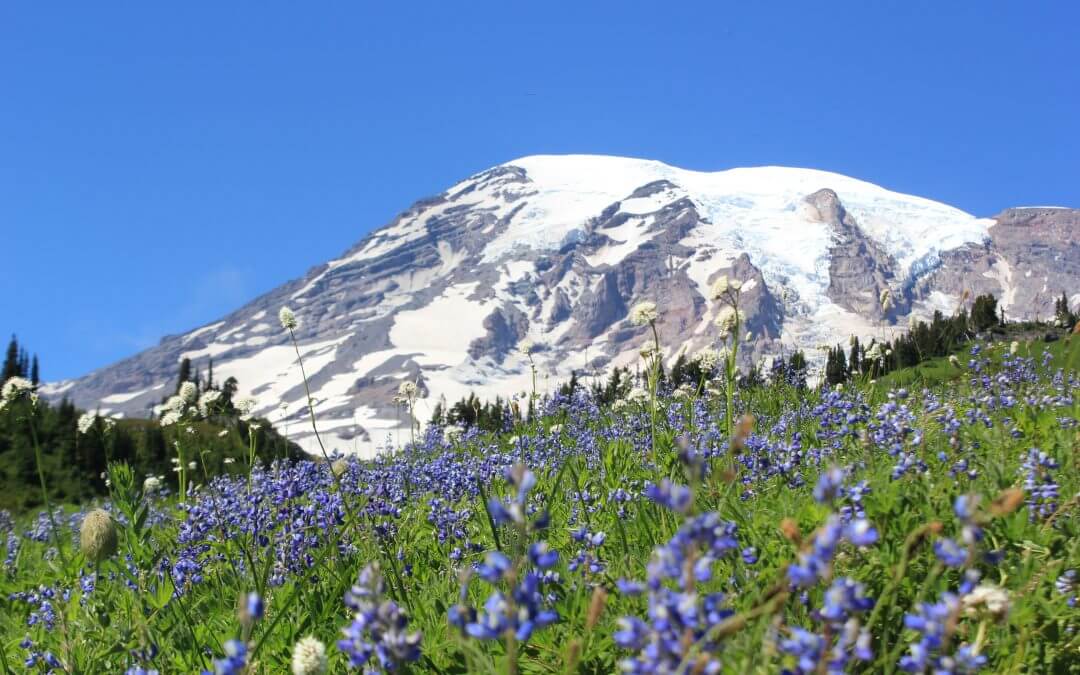
FIVE REASONS TO VISIT MT. RAINIER IN LATE SUMMER
My son chose July 31 for his wedding because it has historically been the best summer day in Western Washington. True again this year, so we rushed off to Mt. Rainier National Park. Here’s why:
1. Mt. Rainier National Park has over 260 Miles of prepared trails
Mt. Rainier is a hiker’s paradise. Choose from a variety of trails, from flat and relatively simple to steep and challenging, or scale the mountain if you’re so inclined. The hardest part for me was picking the time of day for optimum photo opportunities.
Make Sunrise your first early-morning stop, when the eastern glaciers glow in the morning light. At 6,400 feet, Sunrise is the highest vehicle-accessible point. The trails rise from the Visitor Center.
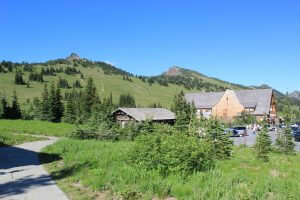 They take you above the timberline and drop you face-to-mountain-face with the magnificent Rainier, or Tahoma, as the native Yakimas named the mother of all rivers.
They take you above the timberline and drop you face-to-mountain-face with the magnificent Rainier, or Tahoma, as the native Yakimas named the mother of all rivers.
From Sour Dough Ridge to Dege Peak you will see Mt. Adams and Mt. Baker and understand how Mt. Rainier links into the chain of volcanoes forming the Ring of Fire.
A good hike for noontime takes you along the Ohanapecosh River to Silver Falls. The high sun shines directly into the narrow canyon, teasing out the emerald green of the water and illuminating the falls. The trail can be steep, but the view from the bridge is lovely.
From here you can hike or drive to the Grove of the Patriarchs on Stevens Canyon Road. A hike along the Ohanapecosh River takes you across a swinging bridge to an island.
There, a boardwalk trail winds through a majestic old growth forest, reminiscent of the giant Sequoias in California or the Cathedral Grove on Vancouver Island.
For serious hikers, the 93-mile Wonderland Trail, considered world-class, covers a large area of the park and shares parts of the Pacific Crest Trail. The casual hiker can attack Wonderland in segments over a number of days or years.
2. Wild Flowers Paint an Impressionistic Landscape Rising Toward the Mountain
Late July and August are inspirational at Paradise, where the wildflower trails feature a palette of colors fanning out below Mt. Rainier.
3. From Tents to Parkitecture, Atmosphere Is the Theme
On our first night, we stayed outside the park. Though the mountain watched over our sleep,
the accommodations were—how shall I put it—vintage motel? If you want the full National Park experience, stay inside the park.
Built near main hiking attractions, park accommodations not only allow access to solitude during the uncrowded hours of the day, but they also get visitors out of their cars to decrease our carbon footprint.
Campgrounds like the Ohanapecosh are basic but well situated. A river runs through it.
Being lulled to sleep by the rushing water and waking up to the fresh smell of pine is worth the price of admission.
Plus, great trails are right outside your tent flap. No need to drive.
When WWI cut off international travel and launched the “See America First” movement, Director of the National Parks, Steven Mather, set out to draw travelers to the National Parks. How? Luxury hotels, built in a Swiss chalet style that was nicknamed Parkitecture. The beauty of architecture remains in the oldest NPS hotel, the Paradise Inn. The lobby is grand, rustic, and cozy all at once.
The luxury, well that depends on your definition. The rooms are not so much Four Seasons as Club Med, which means functional sleeping inside, luxurious scenery outside. Food quality throughout the National Parks system is uneven. I have had everything from a gourmet lunch at the Lake Yellowstone Hotel to this week a $10.75 Caesar Salad, so frozen I had to lay the lettuce out in the sun to thaw. So keep in mind, the luxury is: location, location, location.
One great advantage of the Paradise Inn is that it eliminates the parking rat race because you’re just steps away from the wildflower trails.
4) Dare yourself to encounter a volcano
The Visitor Center exhibit at Sunrise lets you know that this volcano is still alive. Seismographs record tiny earthquakes while steam releases through vents. Some areas of the glacier are encircled by bare rock where escaping heat melts the ice.
A sudden increase on the seismographs will serve as an early warning signal so everyone has a heads up to head out.
5. Ranger Talks and NPS Programs
Where else can you learn so much about your world in such an engaging way? The Park Rangers at Mt. Rainier give you history, science, and conservation, all for free.
The Ranger talk at the Paradise shared the Inn history including its renovations, the first one to keep it from sliding downhill and the last in 2006, to retrofit it against earthquakes. This piano in the lobby provided the only entertainment in the snowy winter for the lonely caretakers, who had to exit the hotel through a third-floor window.
On the wildflower hike, Ranger Gwen not only named the flowers but gave us a free picture list and explained who eats what.
Bears love Beargrass. Marmots dine at the whole wildflower banquet, storing enough in their systems to get through the harsh mountain winters. Because the wildflowers are so crucial to ecological sustainability, the Rangers spend a lot of time asking people to stay on the paths. As they say in the Park newspaper, the magnificent wonders in this park didn’t happen overnight. Such beauty is hundreds or thousands of years in the making. Respect it.
Mt. Rainier has changed its mission over the last 100 years, and next week I’ll explain what has happened and how citizens can get involved. In the meantime, leave your comments below.

